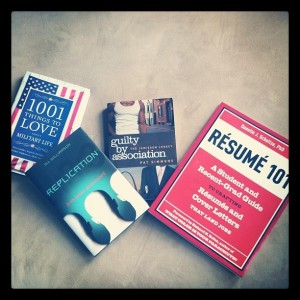- Agents
- Author News, Deals
- Awards
- Bad Poetry
- Blog News
- Books
- Career
- CBA
- Collaborating and Ghosting
- Conferences
- Current Affairs
- Deep Thoughts
- Favorite Books
- Featured
- Film
- Marketing and Platforms
- Proposals
- Publishing
- Questions from Beginners
- Quick Tips
- Religion
- Resources for Writing
- Self-Publishing
- Social Media Critique
- The Business of Writing
- The Writing Craft
- Thursdays with Amanda
- Trends
- Uncategorized
- Web/Tech
Category : Web/Tech
-
Continue Reading "Thursdays with Amanda: Social Media Critiques Part 4"
Thursdays with Amanda: Social Media Critiques Part 4
Amanda Luedeke is a literary agent with MacGregor Literary. Every Thursday, she posts about growing your author platform. You can follow her on Twitter @amandaluedeke or join her Facebook group to stay current with her wheelings and dealings as an agent.
A few weeks ago, I offered free social media critiques to those who replied before the 14th. You see, social media is a specialty of mine. Before becoming an agent, I worked for some years as a social media marketer at a marketing agency outside of Chicago. I worked with clients such as Vera Bradley, Peg Perego, Benjamin Moore and more. A somewhat longer description of what I did can be found in the first critique post.
1. Back Porch Reflections is a blog by Jackie
- I don’t really know what this blog is trying to achieve. It seems like a sports or news blog with a mommy twist, but the title of the blog indicates it’s a personal journey type of thing. :/
- I also struggle with the goal behind each post. Clearly, you’re into sports. But jumping from a very journalistic post on 10/05 to what starts as a journalistic post but ends more like a food-for-thought post on 09/30 to another journalistic-type/info-sharing post on 09/19 to further down the page where you have very personal posts. Clearly, you need to identify both your writing style and your theme for the blog.
- Content aside, the design is a bit cluttered on the right nav, and the masthead is pretty lacking. Really be intentional about where you place things and how it looks (for example, in my browser there’s an Amazon ad that is kind of hanging in no-man’s land).
- Get rid of ads.
RECOMMENDATIONS: Choose a theme and a writing style to go along with that theme. Remember, if you go with a journalistic approach, you aren’t going to be followed for your
-
Continue Reading "Thursdays with Amanda: Social Media Critiques Part 3"
Thursdays with Amanda: Social Media Critiques Part 3
Amanda Luedeke is a literary agent with MacGregor Literary. Every Thursday, she posts about growing your author platform. You can follow her on Twitter @amandaluedeke or join her Facebook group to stay current with her wheelings and dealings as an agent.
A few weeks ago, I offered free social media critiques to those who replied before the 14th. You see, social media is a specialty of mine. Before becoming an agent, I worked for some years as a social media marketer at a marketing agency outside of Chicago. I worked with clients such as Vera Bradley, Peg Perego, Benjamin Moore and more. A somewhat longer description of what I did can be found in the first critique post.
1. The Messy Middle is a blog by Amy Young
- I’m not sure the aesthetics of the site complement the goal. When I first brought it up, I almost expected it to be a site on architecture or interior design. There’s just not much color, and so it has a very cold feel (lots of grays). Your font tries to warm things up, but the masthead is so overpowering with its stark image and cold color scheme that it just doesn’t feel like a place “where grace and truth reside”
- Your “about” page, though creative, is a bit too meandering. When faced with the issue noted above, I had to rely on this page to give me a clear picture of what I should expect from the blog. It took awhile to get that picture, and I’m afraid you’re going to lose potential readers as a result.
- You’ve tapped into a subject matter that could result in a good following (woman is transplanted into foreign culture; must make a way). But there’s a delicate balance between journaling your experience and making the reader feel as though they’re part of it. Because that’s why people read blogs like yours…they
-
Continue Reading "Thursdays with Amanda: How to Create Your Own Masthead"
Thursdays with Amanda: How to Create Your Own Masthead
Amanda Luedeke is a literary agent with MacGregor Literary. Every Thursday, she posts about growing your author platform. You can follow her on Twitter @amandaluedeke or join her Facebook group to stay current with her wheelings and dealings as an agent.
One of the things I’ve noticed when going through your blogs is that many of you rely solely on pre-made templates for your blog design. You may type a few words as a header, but for the most part, you’ve done nothing to customize the space and make it your own. I’m guessing this is because many of you don’t know how easy creating your own masthead can be! I mean, I CREATED MINE USING MICROSOFT PAINT, FOR CRYING OUT LOUD!
Here’s my personal blog, Swedish Pankakes. (Remember! My blog is NOT a shining example of what to do. I’m not trying to grow a platform with it or gain attention, so I don’t implement many of my own tips). If you visit my blog, you’ll see that it looks very personalized and maybe even a smidge professional. But I use a free template with very little customization options. So what makes it look so unique? My masthead!
 This little doo-dad can make a world of difference in getting your blog to look more professional. And I’m going to show you how I did it.
This little doo-dad can make a world of difference in getting your blog to look more professional. And I’m going to show you how I did it.1. You must find a picture that not only fits your blog/website’s vibe, but one that is visually appealing, clean (you don’t want it too busy) and full of colors that you can build your site around. So, let’s say that I was going to create an agent blog. I’d select this picture I took that showcases the first four books I did as an agent:
 2. Open the picture in whatever design program you have or know how to use. All I have is Microsoft Paint (this comes standard with any
2. Open the picture in whatever design program you have or know how to use. All I have is Microsoft Paint (this comes standard with any -
Continue Reading "Thursdays with Amanda: How to Use Tumblr to Grow an Author Platform"
Thursdays with Amanda: How to Use Tumblr to Grow an Author Platform
Amanda Luedeke is a literary agent with MacGregor Literary. Every Thursday, she posts about growing your author platform. You can follow her on Twitter @amandaluedeke or join her Facebook group to stay current with her wheelings and dealings as an agent.
We’ve talked before about blogging, but this week I wanted to cover something called microblogging.
Microblogging is exactly what it sounds like…it’s a smaller, more condensed form of blogging. Images are usually the focus of such microblogs, but they can also be text-based.
Here are some of my favorite microblogs:
- KateMiddletonForTheWin – I have a major girlcrush on Kate. But these make me laugh every time.
- SlushPile Hell – I wish I would have thought of this first.
- Clients From Hell – Maybe it’s my marketing background that makes this microblog so appealing? I don’t think any of the microposts surprised me. They just fueled my rage.
By now you should have a small understanding of microblogging…short posts, centered around a theme (whether visual or theoretical). And if you noticed, each of the examples I gave use Tumblr as their site’s service provider. It’s really the leading host for this approach to blogging.
Okay, so why should authors care about microblogging?
- It’s quick. Constructing a traditional blog post can take hours, depending on how finicky you are. Microblogging takes a fraction of that time, using a fraction of those words.
- It’s focused. I know I keep hounding you about having a goal…well, microblogging is a great example of a medium that simply won’t work without a goal. It practically forces you to choose a topic, preventing you from microblogging about flowers one day, Mozart the next, then your dog, then your deep thoughts on black holes followed by a reposted tribute to AC/DC.
- It’s clean. No fancy backgrounds. No design expertise needed. Just clean and simple…ideal for the digital n00b.
But how can Tumblr and microblogging
-
Continue Reading "Thursdays with Amanda: Creating a Website as an Unpublished Author – Linking to Social Media"
Thursdays with Amanda: Creating a Website as an Unpublished Author – Linking to Social Media
Amanda Luedeke is a literary agent with MacGregor Literary. Every Thursday, she posts about growing your author platform. You can follow her on Twitter @amandaluedeke or join her Facebook group to stay current with her wheelings and dealings as an agent.
As we’ve been discussing growing your platform, one of my rules has been Don’t start too big. Start small. Give Facebook a try and when you feel you have that under control, then move on to Twitter. You’ll shoot yourself in the foot if you launch author versions of Facebook, Twitter, Pinterest, and YouTube all at once. Trust me, you’ll want to die. So focus on one thing. But along with that one thing, you should also have a website.
Last week, we discussed what type of content unpublished authors should include in their websites, and the week before we discussed why an unpublished author needs a website in the first place. If you haven’t read those, take the time to catch up. I really believe it’s valuable content not only for unpublished authors, but new authors.
As a quick recap, an unpublished author’s website should have two goals: The first goal would be to provide editors, agents and the publishing world with a better picture of who you are and what you’re about. The second goal would be to utilize your website as a central hub for all of your social media ventures.
Since last week we discussed Goal #1, this week, we’re looking at Goal #2.
When you’re just starting out, it can be so great when a stranger or acquaintance takes a serious interest in your writing. Maybe they overheard you say that you’re writing a book, or maybe they saw you typing away at Starbucks and had to say something. Maybe they met you on a message board that focuses on your genre or maybe you buddied up at a writer’s conference. When
-
Continue Reading "Thursdays with Amanda: Creating a Website as an Unpublished Author – What Content Do I Include?"
Thursdays with Amanda: Creating a Website as an Unpublished Author – What Content Do I Include?
Amanda Luedeke is a literary agent with MacGregor Literary. Every Thursday, she posts about growing your author platform. You can follow her on Twitter @amandaluedeke or join her Facebook group to stay current with her wheelings and dealings as an agent.
Last week we talked about why unpublished writers need author websites. The post built a case for the usefulness of maintaining an author site–not only to gather fans, but to entertain agents like myself who may wander over there after reading your query. (Yes, this happens.)
But we didn’t talk much about what sort of content to include. I mean, what is there to say when you don’t have a book? Well, there’s a lot to say…but we’ll get to that later.
When building a website as an unpublished author, you’ll probably have two goals. The first goal would be to provide editors, agents and the publishing world with a better picture of who you are and what you’re about. The second goal would be to utilize your website as a central hub for all of your social media ventures. That way, when you meet someone who is excited about your writing, you don’t have to give them your Twitter handle, Facebook link, blog URL and so on. You just give them your website url, and they’ll be able to navigate your social media channels however they prefer.
This week, let’s focus on Goal #1…
What you should include on your author website…
1. An awesome masthead. The masthead, or banner, is the chunk of pretty design that sits at the top of most websites. If you note Susan Sleeman’s masthead, she not only has her author name front and center, but she has a tagline and really awesome buttons that link to her social media. This is the type of masthead you want! One that pulls people in.
I realize most authors get hung
-
Continue Reading "From Amanda: How to Format Your Manuscript for Submission and Kindle Upload"
From Amanda: How to Format Your Manuscript for Submission and Kindle Upload
Amanda Luedeke is a literary agent with MacGregor Literary. You can follow her on Twitter @amandaluedeke or join her Facebook group to stay current with her wheelings and dealings as an agent.
First, I'd like to say I'm sorry for missing my post yesterday. I had some personal things come up and just didn't get around to it. So, we're going to take a slight detour this week, since I know there are a number of people who tune in specifically on Thursdays to hear about building author platform. And, well, we don't want them missing the next installment, now, do we?!
So for today, I'd like to share links to a batch of really helpful tutorial videos my author, the fabulous Jill Williamson, put together. They cover everything you need to know to format your manuscript for submission.
Formatting a Manuscript, Part 1: Page Set Up and Text– http://www.youtube.com/watch?v=boP5po6aMDk&feature=relatedFormatting a Manuscript, Part 2: Page Breaks– http://www.youtube.com/watch?v=9nU1iv2v95s&feature=relatedFormatting a Manuscript, Part 3: Paragraphs– http://www.youtube.com/watch?v=TwqvmdWDJto&feature=relatedFormatting a Manuscript, Part 4: Cleaning things up– http://www.youtube.com/watch?v=RNOj9ZR88E8&feature=relatedFormatting a Manuscript, Part 5: Page Numbers– http://www.youtube.com/watch?v=UOuihsC7SyY&feature=relatedIn addition to this, Jill put together a series of videos for formatting your manuscript for upload on Amazon as a Kindle ebook.Formatting Your Manuscript for Amazon Kindle–PART 1– http://www.youtube.com/watch?v=RU2kprKRrGY&feature=relatedUsing Mobipocket to Format Your Book For Kindle–PART 2– http://www.youtube.com/watch?v=e4szEhEhHy4&feature=relatedThey're short and to the point…excellent references for anyone getting ready to do something with that polished, perfected manuscript.Do you know of any tutorials to add to this list? Tell us about them!And tune in next Thursday when we get back to our discussion on building platforms…the topic? Platform-building blogging. See you next week! -
Continue Reading "Writers and Websites"
Writers and Websites
I've received a number of questions about websites and e-books recently…Ellen has a very thoughtful question: "I've become a smarter book-buyer because of the economy. I'm more likely to read three chapters in the cafe at Borders before letting go of my money. If the writing isn't good, I don't buy the book. If the writing is great, I'll buy it no matter what it costs. But that raises a question — could Kindle increase sales by eliminating our ability to loan out our precious books? And won't Kindles and Sony e-readers affect the used book market?"
For those unfamiliar, the Kindle is Amazon's latest attempt to control the world. It's a small electronic book that uses cell-phone technology to download book texts, and it's great (except it doesn't do graphics). The Sony e-reader is a bit less expensive and bit sturdier, though I'll admit I like using the Kindle more. Ellen's question is one publishers have been rolling around — there's no forwarding from one e-reader to another, so will these tools keep readers from passing along books to friends? That could cut down on the readership of a book. But at the same time, if an enthusiastic reader tells all her friends to read the latest Paul Coelho novel, could they all purchase and download it, thereby increasing sales?
Both are good thoughts. And to this point, nobody knows what will happen. However, I used Brazilian author Paulo Coelho as a specific example because of his recent discussion at the Frankfurt Book Fair last week. Mr. Coelho takes the approach that getting his words out there in electronic form will bring him new readers, and that will lead to more people buying books. So he gets his words out there in the ethernet, and gives them away quite a bit, and he believes that is what has led to his worldwide success. "The more you give, the


